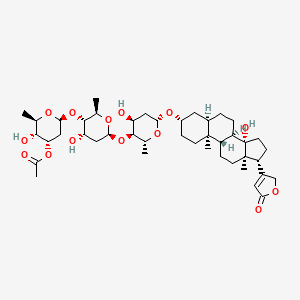



1. Acedoxin
2. Acetyldigitoxins
3. Adicin
4. Alpha Acetyldigitoxin
5. Alpha-acetyldigitoxin
6. Desglucolanatosides A
7. Digitoxin Monoacetate
8. Monoacetate, Digitoxin
1. Alpha-acetyldigitoxin
2. 1111-39-3
3. Acylanid
4. Desglucolanatoside A
5. Acetyldiginatin
6. Acylanide
7. Acetildigitoxina
8. Alpha-monoacetyldigitoxin
9. Acetyldigitoxinum
10. Acetyl-digitoxin-alpha
11. Acetylgitoxin
12. Digitoxin 3'''-acetate
13. Acetyldigitoxin [inn]
14. 3'''-o-acetyldigitoxin
15. Alpha-acetylgitaloxin
16. Acetyldigitoxin (inn)
17. 0zv4q4l2fu
18. Acetyldigitoxins .alpha.-form
19. Chebi:53773
20. (3beta,5beta)-3-((o-3-o-acetyl-2,6-dideoxy-beta-d-ribo-hexopyranosyl-(1->4)-o-2,6-dideoxy-beta-d-ribo-hexopyranosyl-(1-4)-2,6-dideoxy-beta-d-ribo-hexopyranosyl)oxy)-14-hydroxycard-20(22)-enolide
21. Acedigal
22. Adicin
23. [(2r,3r,4s,6s)-3-hydroxy-6-[(2r,3s,4s,6s)-4-hydroxy-6-[(2r,3s,4s,6r)-4-hydroxy-6-[[(3s,5r,8r,9s,10s,13r,14s,17r)-14-hydroxy-10,13-dimethyl-17-(5-oxo-2h-furan-3-yl)-1,2,3,4,5,6,7,8,9,11,12,15,16,17-tetradecahydrocyclopenta[a]phenanthren-3-yl]oxy]-2-methyloxan-3-yl]oxy-2-methyloxan-3-yl]oxy-2-methyloxan-4-yl] Acetate
24. Digitoxin, 3'''-acetate
25. Acylanid (tn)
26. Acetyldigitoxinum [inn-latin]
27. Alpha-acetyldigitoxins
28. Acetildigitoxina [inn-spanish]
29. Digitoxin, Alpha-acetyl-
30. Acetyldigitoxin [inn:nf]
31. Unii-0zv4q4l2fu
32. Acetyldigitoxins
33. Einecs 214-178-4
34. Brn 0077291
35. 3'''-acetyldigitoxin
36. Digitoxin, Acetate, Alpha-
37. Schembl309649
38. Gtpl6794
39. Acetyldigitoxin [mart.]
40. Acetyldigitoxin [who-dd]
41. Chembl3545057
42. Acetyldigitoxin [orange Book]
43. Zinc96006012
44. Db00511
45. (3beta,5beta)-3-((o-3-o-acetyl-2,6-dideoxy-beta-d-ribo-hexopyranosyl-(1-4)-o-2,6-dideoxy-beta-d-ribo-hexopyranosyl-(1-4)-2,6-dideoxy-beta-d-ribo-hexopyranosyl)oxy)-14-hydroxycard-20(22)-enolide
46. (3beta,5beta)-3-{[3-o-acetyl-2,6-dideoxy-beta-d-ribo-hexopyranosyl-(1->4)-2,6-dideoxy-beta-d-ribo-hexopyranosyl-(1->4)-2,6-dideoxy-beta-d-ribo-hexopyranosyl]oxy}-14-hydroxycard-20(22)-enolide
47. 3beta-[3-o-acetyl-2,6-dideoxy-beta-d-ribo-hexopyranosyl-(1->4)-2,6-dideoxy-beta-d-ribo-hexopyranosyl-(1->4)-2,6-dideoxy-beta-d-ribo-hexopyranosyloxy]-14-hydroxy-5beta-card-20(22)-enolide
48. Hy-16022
49. Acetyldigitoxins .alpha.-form [mi]
50. Cs-0006116
51. C22191
52. D06881
53. (2r,3r,4s,6s)-3-hydroxy-6-{[(2r,3s,4s,6s)-4-hydroxy-6-{[(2r,3s,4s,6r)-4-hydroxy-6-{[(1s,2s,5s,7r,10r,11s,14r,15r)-11-hydroxy-2,15-dimethyl-14-(5-oxo-2,5-dihydrofuran-3-yl)tetracyclo[8.7.0.0^{2,7}.0^{11,15}]heptadecan-5-yl]oxy}-2-methyloxan-3-yl]oxy}-2-methyloxan-3-yl]oxy}-2-methyloxan-4-yl Acetate
54. (3.beta.,5.beta.)-3-((o-3-o-acetyl-2,6-dideoxy-.beta.-d-ribo-hexopyranosyl-(1->4)-o-2,6-dideoxy-.beta.-d-ribo-hexopyranosyl-(1->4)-2,6-dideoxy-.beta.-d-ribo-hexopyranosyl)oxy)-14-hydroxycard-20(22)-enolide
55. Card-20(22)-enolide, 3-((o-3-o-acetyl-2,6-dideoxy-beta-d-ribo-hexopyranosyl-(1-4)-o-2,6-dideoxy-beta-d-ribo-hexopyranosyl-(1-4)-2,6-dideoxy-beta-d-ribo-hexopyranosyl)oxy)-14-hydroxy-, (3beta,5beta)-
| Molecular Weight | 807.0 g/mol |
|---|---|
| Molecular Formula | C43H66O14 |
| XLogP3 | 2.8 |
| Hydrogen Bond Donor Count | 4 |
| Hydrogen Bond Acceptor Count | 14 |
| Rotatable Bond Count | 9 |
| Exact Mass | 806.44525677 g/mol |
| Monoisotopic Mass | 806.44525677 g/mol |
| Topological Polar Surface Area | 189 Ų |
| Heavy Atom Count | 57 |
| Formal Charge | 0 |
| Complexity | 1520 |
| Isotope Atom Count | 0 |
| Defined Atom Stereocenter Count | 20 |
| Undefined Atom Stereocenter Count | 0 |
| Defined Bond Stereocenter Count | 0 |
| Undefined Bond Stereocenter Count | 0 |
| Covalently Bonded Unit Count | 1 |
Used for fast digitalization in congestive heart failure.
The main pharmacological effects of acetyldigitoxin are on the heart. Extracardiac effects are responsible for many of the adverse effects. Its main cardiac effects are 1) a decrease of conduction of electrical impulses through the AV node, making it a commonly used drug in controlling the heart rate during atrial fibrillation or atrial flutter, and 2) an increase of force of contraction via inhibition of the Na+/K+ ATPase pump.
Enzyme Inhibitors
Compounds or agents that combine with an enzyme in such a manner as to prevent the normal substrate-enzyme combination and the catalytic reaction. (See all compounds classified as Enzyme Inhibitors.)
Cardiotonic Agents
Agents that have a strengthening effect on the heart or that can increase cardiac output. They may be CARDIAC GLYCOSIDES; SYMPATHOMIMETICS; or other drugs. They are used after MYOCARDIAL INFARCT; CARDIAC SURGICAL PROCEDURES; in SHOCK; or in congestive heart failure (HEART FAILURE). (See all compounds classified as Cardiotonic Agents.)
Anti-Arrhythmia Agents
Agents used for the treatment or prevention of cardiac arrhythmias. They may affect the polarization-repolarization phase of the action potential, its excitability or refractoriness, or impulse conduction or membrane responsiveness within cardiac fibers. Anti-arrhythmia agents are often classed into four main groups according to their mechanism of action: sodium channel blockade, beta-adrenergic blockade, repolarization prolongation, or calcium channel blockade. (See all compounds classified as Anti-Arrhythmia Agents.)
C - Cardiovascular system
C01 - Cardiac therapy
C01A - Cardiac glycosides
C01AA - Digitalis glycosides
C01AA01 - Acetyldigitoxin
Absorption
Bioavailability is 60 to 80% following oral administration.
Acetyldigitoxin binds to a site on the extracellular aspect of the α-subunit of the Na+/K+ ATPase pump in the membranes of heart cells (myocytes). This causes an increase in the level of sodium ions in the myocytes, which then leads to a rise in the level of calcium ions. The proposed mechanism is the following: inhibition of the Na+/K+ pump leads to increased Na+ levels, which in turn slows down the extrusion of Ca2+ via the Na+/Ca2+ exchange pump. Increased amounts of Ca2+ are then stored in the sarcoplasmic reticulum and released by each action potential, which is unchanged by acetyldigitoxin. This is a different mechanism from that of catecholamines. Acetyldigitoxin also increases vagal activity via its central action on the central nervous system, thus decreasing the conduction of electrical impulses through the AV node. This is important for its clinical use in different arrhythmias.